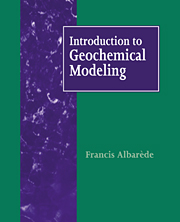Book contents
- Frontmatter
- Contents
- Foreword
- Preface
- 1 Mass balance, mixing, and fractionation
- 2 Linear algebra
- 3 Useful numerical analysis
- 4 Probability and statistics
- 5 Inverse methods
- 6 Modeling chemical equilibrium
- 7 Dynamic systems
- 8 Transport, advection, and diffusion
- 9 Trace elements in magmatic processes
- References
- Subject index
8 - Transport, advection, and diffusion
Published online by Cambridge University Press: 05 February 2010
- Frontmatter
- Contents
- Foreword
- Preface
- 1 Mass balance, mixing, and fractionation
- 2 Linear algebra
- 3 Useful numerical analysis
- 4 Probability and statistics
- 5 Inverse methods
- 6 Modeling chemical equilibrium
- 7 Dynamic systems
- 8 Transport, advection, and diffusion
- 9 Trace elements in magmatic processes
- References
- Subject index
Summary
Fluxes
Basic definitions
We already used the concept of conservative process in Chapter 1. In the present context, conservative properties are scalar, vector, or even tensor variables that can be added or subtracted. They can only be modified by exchange with the surrounding across interfaces and by being locally stored in sinks or locally released from sources. Mass and energy are conservative scalar properties, concentration and temperature are not. Momentum is a conservative vector property, velocity in general is not. A flux represents an ‘amount’ of a conservative property transported in a given time across a boundary, an outlet, or an imaginary surface. It may be a number of cars driving on a highway on Sunday, the mass of water running through a fault zone in a year, the heat flow across the Earth's surface or the vector describing the rate of transport of electromagnetic energy through space. In proper words, we should call flux density whatever flux refers to a unit time and a unit surface and reserve the use of flux for less specific situations. As common usage has unfortunately decided differently, we will have to be careful about the possible ambiguities associated with flux denomination.
Let us consider a medium moving with velocity v (components vx, vy, vz). A medium with non-zero velocity is said to be advective. Let us first define in the most general way the flux of volume at a point M of the familiar 3D space: this is simply the quantity of volume moving across the unit surface perpendicular to v per unit time.
- Type
- Chapter
- Information
- Introduction to Geochemical Modeling , pp. 401 - 476Publisher: Cambridge University PressPrint publication year: 1995



